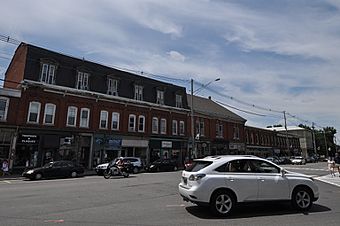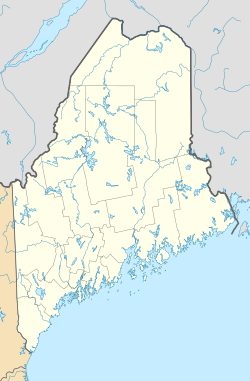South Berwick Village Historic District facts for kids
Quick facts for kids |
|
|
South Berwick Village Historic District
|
|

Main Street in the village center
|
|
| Location | Portions of Main, Portland, Highland and Academy, South Berwick, Maine |
|---|---|
| Area | 82 acres (33 ha) |
| Built | 1805 |
| Architect | Hutchens & French; et al. |
| Architectural style | Georgian, Federal |
| NRHP reference No. | 10000058 |
| Added to NRHP | March 2, 2010 |
The South Berwick Village Historic District is a special area in South Berwick, Maine. It includes the old, historic part of the village. People first settled here in the 1640s. In the early 1800s, the village grew a lot. It was on an important road between Boston, Massachusetts and Portland, Maine. This district shows off about 150 years of history through its buildings. It was added to the National Register of Historic Places in 2010. This means it's an important place to protect.
Contents
Discovering South Berwick Village History
The center of South Berwick village is in the northwestern part of town. It sits on a flat area above the Salmon Falls River. This river separates Maine from Rollinsford, New Hampshire. European settlers bought this land from Native Americans in 1643.
Early Village Growth and River Trade
The first parts of the village grew near the Salmon Falls River. This was because the river was a good place for boats to travel. Large trees were cut down and sent from here to England. These trees were used to make tall ship masts.
The Plains and Road Development
Later, the area called "The Plains" became more important. This is where the main village is today. In the late 1700s, a major road connected Boston, Portsmouth, and Portland. South Berwick became a popular stop for stagecoaches on this route. Because of this, the town center moved away from the river.
Rebuilding After the Great Fire
In 1845, a big fire destroyed many wooden shops and buildings in the town center. After the fire, people built new buildings. Many of these new buildings were made of brick. Some of these brick buildings are still standing today.
Exploring the Historic District's Features
The main part of the historic district is where Main Street (Maine State Route 236) and Portland Street (Maine State Route 4) meet. The district spreads out from this crossing. It goes north, south, and east along these roads. It also includes small parts of Academy Street, Highland Avenue, and Agamenticus Road.
Important Buildings and Landmarks
You can see many interesting things in the district. On the west side of Main Street, there are many old shops. The Sarah Orne Jewett House is a famous museum. It is a National Historic Landmark and stands at the corner of Main and Portland streets. There is also a small park near the eastern end of Portland Street.
Churches Marking the District's Ends
Churches help mark the edges of the district. The Free Will Baptist Church is at the north end of Main Street. At the southern end, you will find the Federated Church and the Baptist Church. These buildings show the long history of the village.



